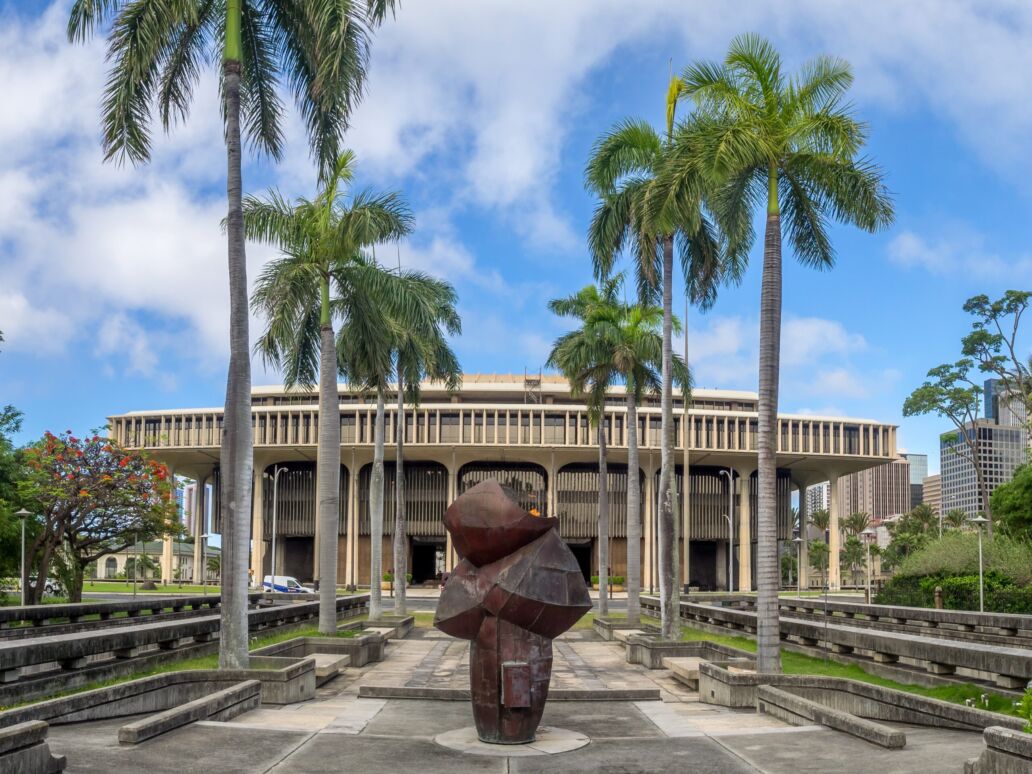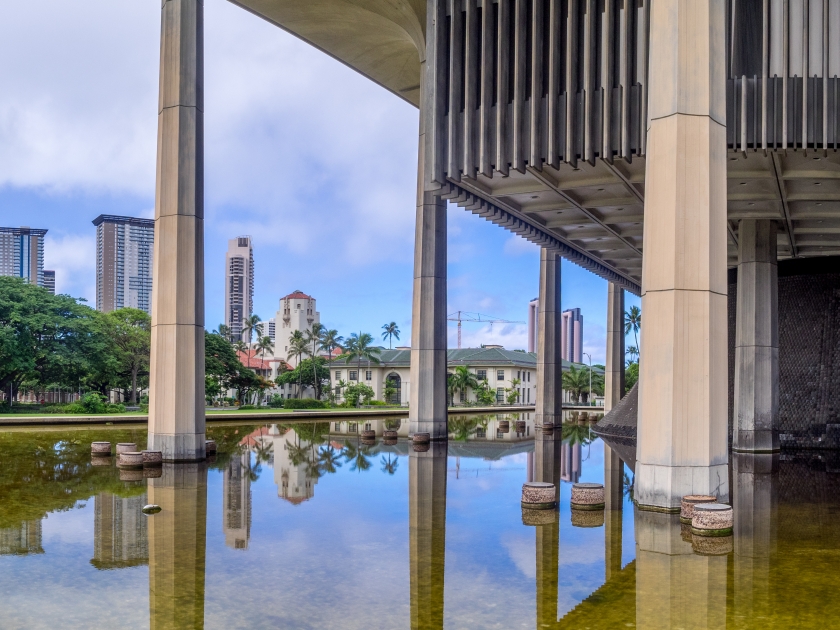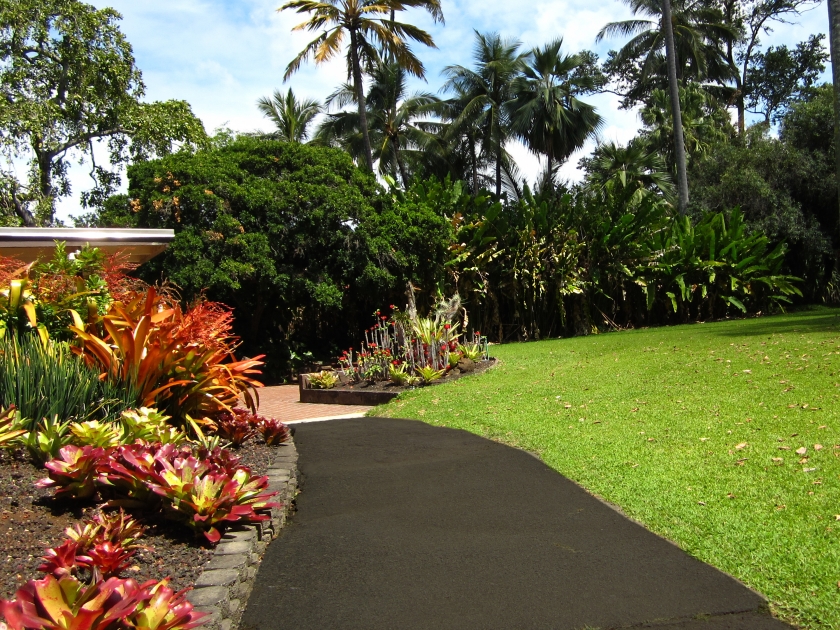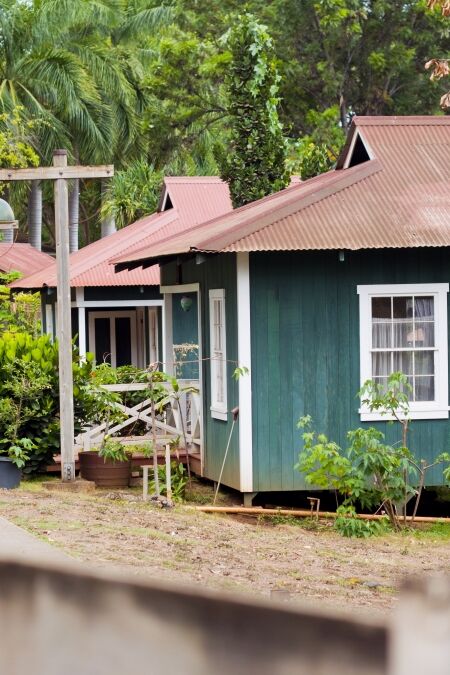The Hawaii State Capitol in Honolulu stands as a modern architectural marvel, reflecting not just the unique beauty of the islands but also its legislative heart. Its open-air design, accentuated by the reflective pools that suggest Hawaii’s surrounding ocean, reinterprets the traditional capitol building with a distinctively local flair. The following travel guide article intends to provide visitors with a deeper understanding of the Hawaii State Capitol’s historical significance, architectural nuances, and the part it plays in the civic life of Hawaii. It aims to enrich the travel experience for those intrigued by the stories and structures that define a destination.
Highlights
- The Hawaii State Capitol boasts a unique architectural design, featuring a striking modernist style with its distinctive cone-shaped legislative chambers and open-air structure.
- Enjoy a stroll through the well-maintained grounds surrounding the Capitol.
- Take a guided tour or attend a legislative session to witness democracy in action within the Capitol’s legislative chambers, where important decisions are made that shape the future of Hawaii.
- Immerse yourself in Hawaiian culture and heritage by exploring the various exhibits housed within the Capitol.
- Admire the array of captivating art installations scattered throughout the Capitol complex.
History

A Modern Marvel Emerges: Hawaii State Capitol
In 1969, the Hawaii State Capitol emerged as a symbol of modern governance, replacing the iconic Iolani Palace. Formerly the royal residence, the Palace transitioned into a museum, offering visitors a glimpse into Hawaiian history. The Capitol, located in downtown Honolulu, serves as the official seat of Hawaii’s government, housing the executive and legislative branches.
Architectural Significance and Monuments
Commissioned by Governor John A. Burns, the Capitol stands as a testament to innovative design. Surrounding the building are monuments rich in historical and cultural significance. The Queen Liliʻuokalani Statue, dedicated in 1982, commemorates the royal lineage. The Liberty Bell, a gift symbolizing freedom, greets visitors at the Beretania Street entrance. Notable too is the Father Damien Statue, honoring the priest’s service to leprosy patients, and the Eternal Flame, a perpetual tribute to Hawaiian service members.
Historical Tribute and Remembrance
The Capitol grounds hold deeper meaning with tributes to Hawaii’s military legacy. The Korean-Vietnam War Memorial, inaugurated in 1994, immortalizes the names of fallen soldiers. Additionally, the Eternal Flame stands as a solemn reminder of the sacrifices made by men and women in various conflicts. Each monument echoes Hawaii’s unwavering commitment to honor and remember those who served.
Architectural Features

Unique design elements
One of the most striking aspects is the absence of a traditional domed capitol roof. Instead, the structure boasts a flat roof lined with a circular reflecting pool, representing the ocean surrounding the islands. The building’s columns, which resemble royal palm trees, extend from the ground and open at the top, symbolically supporting the sky.
Notable interior and exterior features
The exterior is enveloped by a water-filled moat, symbolizing the Pacific Ocean, and visitors enter through bridges, metaphorically connecting the islands to the Capitol. Inside, the legislative chambers are designed to resemble volcanoes, a nod to Hawaii’s geologically dynamic landscape, while the use of natural ventilation instead of artificial air-conditioning highlights the state’s commitment to environmental consciousness.
Symbolism incorporated into the architecture
Beyond its environmental features, the Capitol’s architecture is laden with symbolism. The eight columns on either side of the building represent Hawaii’s main islands, while the wall of the House and Senate chambers, crafted from native koa wood, stands as a tribute to Hawaii’s natural resources and traditions. Moreover, the open-air rotunda and perimeter pool reflect the Hawaiian belief in the transparency of government and the inclusivity of its people.
Points of Interest Inside the Capitol
Legislative Chambers
Visitors to the Hawaii State Capitol can observe democracy in action within the legislative chambers. The Senate and the House of Representatives chambers are open to the public, and they offer a glimpse into the legislative process that shapes the future of Hawaii.
Governor's Office
The executive epicenter of the Hawaiian government, the Governor’s office, is a space of significant importance within the Capitol. Although access may be restricted, it’s a point of interest for its role in state governance.
Public Galleries and Exhibits
The Capitol’s public galleries and exhibits showcase Hawaii’s cultural and political history. Rotating exhibits often feature works by local artists, historical displays, and educational presentations that provide visitors with a deeper understanding of the state’s heritage.
Historical Artifacts and Artworks
Throughout the Capitol, historical artifacts and artistic works tell the story of Hawaii’s past. These curated pieces provide insight into the cultural diversity and historical events that have shaped the islands, offering a profound connection to Hawaii’s heritage.
Surrounding Area Attractions

Nearby parks and green spaces
Just a short walk from the Capitol is the tranquil oasis of the Foster Botanical Garden, an urban garden with a mature and impressive collection of tropical plants. Another serene spot is the Liliuokalani Botanical Garden, dedicated to native Hawaiian plants and the last queen of Hawaii.
Cultural and historical landmarks
History enthusiasts will appreciate the Iolani Palace, the only royal palace on American soil, and the striking King Kamehameha Statue, both located a block away from the Capitol. The Kawaiaha’o Church and the Mission Houses Museum offer a glimpse into the missionary history of Hawaii.
Dining and shopping options
For a taste of local flavors, visitors can head to the nearby Aloha Tower Marketplace, offering a variety of dining options with picturesque views of Honolulu Harbor. Shopping enthusiasts will enjoy the eclectic mix of shops and boutiques in Chinatown, which is also renowned for its vibrant culinary scene, featuring establishments like the historic Maunakea Marketplace and The Pig and The Lady restaurant.
Events and Activities
Special events hosted at the Capitol
Throughout the year, the Hawaii State Capitol hosts several special events that commemorate significant dates in Hawaii’s history, celebrate local culture, and provide public forums for civic engagement. These include Statehood Day, Lei Day celebrations, and the annual Governor’s State of the State address, which offers citizens insights into Hawaii’s plans.
Community gatherings and cultural celebrations
Local community groups and organizations often utilize the Capitol grounds for gatherings and cultural celebrations, such as the King Kamehameha Day floral parade and Hawaiian Music Concert Series. Such events showcase Hawaii’s rich traditions and the aloha spirit that defines the islands.
Educational programs and workshops
Educational opportunities abound at the Capitol, with numerous programs aimed at engaging students, residents, and visitors in the government process and Hawaiian cultural heritage. Workshops on sustainability, legislative procedures, and Hawaiian history are just a few examples of educational outreach that the Capitol facilitates.
Visitor’s Guide to Hawaii State Capitol
Operating hours and admission fees (if any)
The Capitol welcomes visitors from Monday to Friday, 7:00 AM to 5:00 PM, except on state holidays. There is no admission fee, allowing everyone to appreciate the beauty and significance of the location at no cost.
Photography policies
Visitors are encouraged to capture their experiences; photography for personal use is allowed in most public areas. However, the use of tripods or additional photography equipment may require prior permission, and it’s important to be mindful of not disrupting governmental operations or the privacy of individuals.
Guided tour availability and schedule
To fully appreciate the historic and architectural significance of the Capitol, guided tours are available. These can be scheduled in advance by contacting the Public Information Office. The tours offer an in-depth look at the building’s design, artwork, and role in Hawaiian politics. Group tours are typically available on weekdays, but it’s best to book ahead to secure your spot.
Visitor Tips and Guidelines
- Research the opening hours and schedule your visit during times when the legislature is not in session for a more leisurely experience.
- Check online for any scheduled events or closures to avoid disappointment.
- Opt for smart-casual attire as a form of respect for the government premises, especially if you plan to observe legislative proceedings.
- While in the building, be mindful of the decorum suited to a place of governance. Keep noise levels to a minimum and dispose of any litter responsibly.
- The Hawaii State Capitol is equipped with accessibility features, including ramps and elevators, to accommodate visitors with disabilities.
- Accessible parking spaces are available, and service animals are welcome.
- Free guided tours are offered and provide an in-depth understanding of the building’s historical significance and architectural design—booking in advance is recommended.
- Informational brochures and pamphlets are available on-site for visitors who prefer self-guided tours which allow you to explore at your own pace.
Safety and Security Measures
Information on security protocols
Upon entering the Hawaii State Capitol, visitors will go through a security screening process similar to airport checks. All bags are subject to search, and items deemed hazardous are not allowed inside the Capitol. Visitors are encouraged to minimize the number of personal belongings they bring with them to expedite the screening process.
Emergency contact information
In case of an emergency, visitors should immediately notify Capitol security personnel. These highly trained individuals are stationed throughout the building and are prepared to respond to a wide range of situations. For medical emergencies or to report a crime, individuals can dial (808) 935-3311. For fire-related emergencies, visitors should dial 911. Additionally, emergency evacuation routes are marked, and staff are on hand to assist in an orderly and swift evacuation if necessary.
Frequently Asked Questions (FAQs)
The Hawaii State Capitol is architecturally significant for its unique design, which incorporates elements representing Hawaii’s natural environment and culture. It’s also historically significant as the site where important decisions impacting the state are made.
The Hawaii State Capitol is located in downtown Honolulu, on the island of Oahu, at 415 South Beretania Street.
Yes, visitors are welcome to tour the Hawaii State Capitol. Guided tours are available, and visitors can also explore the building on their own.
Weekdays during business hours are the best time to visit, as one can observe the legislature in session and possibly attend hearings or meetings.
Yes, the Hawaii State Capitol is accessible to individuals with disabilities. The building is equipped with ramps, elevators, and other accommodations to ensure accessibility.
Yes, there is parking available for visitors at the Hawaii State Capitol. There are metered parking spaces nearby, as well as paid parking garages in the surrounding area.
How to Get There
By Bus
For those opting for public transportation, the bus system in Honolulu is efficient and convenient. To get to the Capitol by bus, take one of the several routes that stop at the Capitol District, such as Route 2, Route 13, or Route 19. Get off at the stop closest to Beretania St. and Richards St. and the Capitol is just a short walk away.
By Car
If traveling by car, head towards the downtown Honolulu area. The Hawaii State Capitol is located at 415 South Beretania Street. Metered parking is available on the streets surrounding the Capitol, and several public parking garages are situated nearby. The most convenient is probably the Civic Center Parking Lot, accessible from Alapai Street. Be mindful of Honolulu’s traffic, especially during rush hours, and allow extra time for parking.
Experience Firsthand the Vibrancy of Hawaiian Governance!
As you step into the graceful shadow of the Hawaii State Capitol, you’re not just walking through a hub of current politics, but a monument rich with historical and cultural narratives. The Capitol stands not only as a beacon of democracy but as a testament to the islands’ enduring spirit and the importance of civic engagement. By visiting, you actively connect with the past decisions that shaped Hawaii and gain a deeper understanding of its future direction. So come, explore, and let the spirit of aloha guide your experience in one of Honolulu’s most iconic landmarks.




